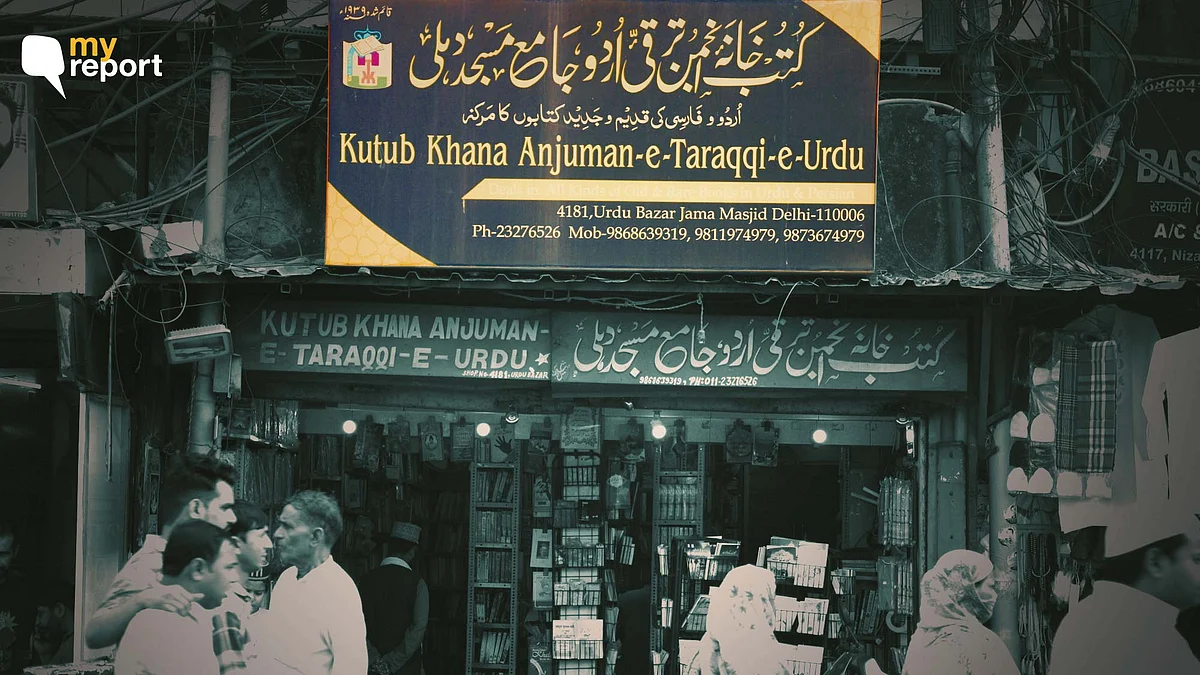
'Urdu Bazaar’s Legacy in Old Delhi Is Slipping Away, One Shop at a Time'
Once a center of Urdu literature, the bazaar today is in ruins.

advertisement
Just opposite gate no.1 of Jama Masjid in Old Delhi lies the long-forgotten Urdu Bazaar. Once a center of Urdu literature, the bazaar today is in ruins.
Barely a few decades back, the market was lined with bookstores, frequently visited by scholars and literature enthusiasts. However, today, only a fraction of the bookstores remains.
The dusty shelves lined with an eclectic collection of Urdu books and the worsening condition of the bookshop itself, are symbolic of the waning prevalence of Urdu as a language.
(Photo Credit: Shamiksha Mallick)
'Hardly 4-5 Books Sell in the Entire Day'
Mohammad Mahfooz Alam, the caretaker of Maktaba Jamia, one of the oldest surviving bookstores in the market, laments the growing association of Urdu with a particular section of the population, namely the Muslims, contributing to a decline in interest in Urdu literature. He adds:
Mohammad Mahfooz Alam, the caretaker of Maktaba Jamia.
(Photo Credit: Shambhavi Srivastava)
Maktaba Jamia was established in 1922 as the publishing arm of Jamia Millia Islamia. It was set up with a mission to propagate Urdu, especially among the younger generations, with no commercial intent. Gradually, it transformed into a big publishing house (Maktaba Jamia Limited) known for its publications spanning every genre of literature.
Once a prominent player in Indian Urdu publishing, Maktaba Jamia Limited only has a few its bookstores remaining, including the one at Urdu Bazaar.
"Even 20 years ago, there were many bookshops here, but poor business forced many owners to close their shops and take up other professions. Some of us are still here, hoping that the situation might improve, though the prospects seem increasingly bleak," Alam adds.
Stacks of Urdu books lying on the shelves, waiting for readers that don't arrive.
(Photo Credit: Shamiksha Mallick)
'Buying Books Out of Question'
Even Kitab Numa, a famous Risala (Urdu journal) published by Maktaba Jamia Limited, is no longer in regular circulation.
Eateries now stand where bookshops once flourished, and the love for food has replaced the thirst for Ghalib's and Faiz's poetry. People no longer visit Urdu Bazaar to buy or read books but rather to enjoy kebabs and biryani, say bookstore owners.
People now visit Urdu Bazaar to enjoy kebabs and biryani, say bookstore owners, says Alam.
(Photo Credit: Shamiksha Mallick)
Dr Liaqat Ali, a professor of Urdu at Indira Gandhi National Open University, believes that the absence of Urdu as a medium of education in schools – and the consequent ease of younger generations in using English and Hindi – explains the declining readership of Urdu.
“Even if the young people are reading Urdu literature and poetry, they are doing it in Hindi or English,” he explains.
“The younger generation is so used to having everything at the click of a button that personally visiting bookstores and buying books seems out of the question,” he adds.
Professor Khwaja Mohammad Ekramuddin, an Urdu professor at Jawaharlal Nehru University in New Delhi, acknowledges the declining readership and highlights the decentralisation of Urdu publishing.
(All 'My Report' branded stories are submitted by citizen journalists to The Quint. Though The Quint enquires into the claims/allegations from all parties before publishing, the report and the views expressed above are the citizen journalist's own. The Quint neither endorses, nor is responsible for the same.)
- Access to all paywalled content on site
- Ad-free experience across The Quint
- Early previews of our Special Projects
Published: undefined